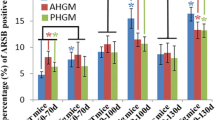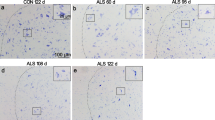Abstract
Amyotrophic lateral sclerosis (ALS) is a progressive and fatal neurodegenerative disease involving both upper and lower motor neurons. The mechanism of motor neuron degeneration is still unknown. Although many studies have been performed on spinal motor neurons, few have been reported on brainstem and its motor nuclei. The aim of this study was to investigate oxidative stress and autophagic changes in the brainstem and representative motor nuclei of superoxide dismutase 1 (SOD1)-G93A mouse model of ALS. The expression levels of cluster of differentiation molecule 11b (CD11b), glial fibrillary acidic protein, glutamate–cysteine ligase catalytic subunit, heme oxygenase-1, NAD(P)H: quinone oxidoreductase 1, voltage-dependent anion-selective channel protein 1, Sequestosome 1/p62 (p62), microtubule-associated protein 1 light chain 3B (LC3), and SOD1 proteins in brainstem were examined by Western blot analysis. Immunohistochemistry and immunofluorescence were performed to identify the cellular localization of SOD1, p62, and LC3B, respectively. The results showed that there were progressive asctrocytic proliferation and microglial activation, induction of antioxidant proteins, and increased p62 and LC3II expression in brainstem of SOD1-G93A mice. Additionally, SOD1 and p62 accumulated in hypoglossal, facial, and red nuclei, but not in oculomotor nucleus. Furthermore, electron microscope showed increased autophagic vacuoles in affected brainstem motor nuclei. Our results indicate that brainstem share similar gliosis, oxidative stress, and autophagic changes as the spinal cord in SOD1-G93A mice. Thus, SOD1 accumulation in astrocytes and neurons, oxidative stress, and altered autophagy are involved in motor neuron degeneration in the brainstem, similar to the motor neurons in spinal cord. Therefore, therapeutic trials in the SOD1G93A mice need to target the brainstem in addition to the spinal cord.











Similar content being viewed by others
References
Wijesekera LC, Leigh PN (2009) Amyotrophic lateral sclerosis. Orphanet J Rare Dis Feb 4:3
Przedborski S, Donaldson DM, Murphy PL, Hirsch O, Lange D, Naini AB, McKenna-Yasek D, Brown RH Jr (1996) Blood superoxide dismutase, catalase and glutathione peroxidase activities in familial and sporadic amyotrophic lateral sclerosis. Neurodegeneration 5:57–64
Chattopadhyay M, Valentine JS (2009) Aggregation of copper-zinc superoxide dismutase in familial and sporadic ALS. Antioxid Redox Signal 11:1603–1614
Pramatarova A, Figlewicz DA, Krizus A, Han FY, Ceballos-Picot I, Nicole A, Dib M, Meininger V, Brown RH, Rouleau GA (1995) Identification of new mutations in the Cu/Zn superoxide dismutase gene of patients with familial amyotrophic lateral sclerosis. Am J Hum Genet 56:592–596
Orrell RW (2000) Amyotrophic lateral sclerosis: copper/zinc superoxide dismutase (SOD1) gene mutations. Neuromuscul Disord 10:63–68
Gordon PH, Salachas F, Lacomblez L, Le Forestier N, Pradat PF, Bruneteau G, Elbaz A, Meininger V (2013) Predicting survival of patients with amyotrophic lateral sclerosis at presentation: a 15-year experience. Neurodegener Dis 12:81–90
Kuhnlein P, Gdynia HJ, Sperfeld AD, Lindner-Pfleghar B, Ludolph AC, Prosiegel M, Riecker A (2008) Diagnosis and treatment of bulbar symptoms in amyotrophic lateral sclerosis. Nat Clin Pract Neurol 4:366–374
Mancuso R, Olivan S, Mancera P, Pasten-Zamorano A, Manzano R, Casas C, Osta R, Navarro X (2012) Effect of genetic background on onset and disease progression in the SOD1-G93A model of amyotrophic lateral sclerosis. Amyotroph Lateral Scler 13:302–310
Haenggeli C, Kato AC (2002) Differential vulnerability of cranial motoneurons in mouse models with motor neuron degeneration. Neurosci Lett 335:39–43
Ferrucci M, Spalloni A, Bartalucci A, Cantafora E, Fulceri F, Nutini M, Longone P, Paparelli A, Fornai F (2010) A systematic study of brainstem motor nuclei in a mouse model of ALS, the effects of lithium. Neurobiol Dis 37:370–383
Nimchinsky EA, Young WG, Yeung G, Shah RA, Gordon JW, Bloom FE, Morrison JH, Hof PR (2000) Differential vulnerability of oculomotor, facial, and hypoglossal nuclei in G86R superoxide dismutase transgenic mice. J Comp Neurol 416:112–125
Reiner A, Medina L, Figueredo-Cardenas G, Anfinson S (1995) Brainstem motoneuron pools that are selectively resistant in amyotrophic lateral sclerosis are preferentially enriched in parvalbumin: evidence from monkey brainstem for a calcium-mediated mechanism in sporadic ALS. Exp Neurol 131:239–250
Whishaw IQ, Gorny B, Sarna J (1998) Paw and limb use in skilled and spontaneous reaching after pyramidal tract, red nucleus and combined lesions in the rat: behavioral and anatomical dissociations. Behav Brain Res 93:167–183
Gurney ME, Pu H, Chiu AY, Dal Canto MC, Polchow CY, Alexander DD, Caliendo J, Hentati A, Kwon YW, Deng HX et al (1994) Motor neuron degeneration in mice that express a human Cu, Zn superoxide dismutase mutation. Science 264:1772–1775
Weydt P, Hong SY, Kliot M, Moller T (2003) Assessing disease onset and progression in the SOD1 mouse model of ALS. Neuroreport 14:1051–1054
Guo Y, Zhang Y, Wen D, Duan W, An T, Shi P, Wang J, Li Z, Chen X, Li C (2013) The modest impact of transcription factor Nrf2 on the course of disease in an ALS animal model. Lab Investig 93:825–833
Paxinos G, Franklin KB (2001) The mouse brain in stereotaxic coordinates. Academic, USA
Zhang K, Shi P, An T, Wang Q, Wang J, Li Z, Duan W, Li C, Guo Y (2013) Food restriction-induced autophagy modulates degradation of mutant SOD1 in an amyotrophic lateral sclerosis mouse model. Brain Res 1519:112–119
Li L, Zhang X, Le W (2008) Altered macroautophagy in the spinal cord of SOD1 mutant mice. Autophagy 4:290–293
Hensley K, Mhatre M, Mou S, Pye QN, Stewart C, West M, Williamson KS (2006) On the relation of oxidative stress to neuroinflammation: lessons learned from the G93A-SOD1 mouse model of amyotrophic lateral sclerosis. Antioxid Redox Signal 8:2075–2087
Yamanaka K, Yamashita H (2007) ALS and microglia—a player for non-cell-autonomous neuron death. Brain Nerve 59:1163–1170
Diaz-Amarilla P, Olivera-Bravo S, Trias E, Cragnolini A, Martinez-Palma L, Cassina P, Beckman J, Barbeito L (2011) Phenotypically aberrant astrocytes that promote motoneuron damage in a model of inherited amyotrophic lateral sclerosis. Proc Natl Acad Sci U S A 108:18126–18131
Guo Y, Duan W, Li Z, Huang J, Yin Y, Zhang K, Wang Q, Zhang Z, Li C (2010) Decreased GLT-1 and increased SOD1 and HO-1 expression in astrocytes contribute to lumbar spinal cord vulnerability of SOD1-G93A transgenic mice. FEBS Lett 584:1615–1622
Gal J, Ström AL, Kilty R, Zhang F, Zhu H (2007) p62 accumulates and enhances aggregate formation in model systems of familial amyotrophic lateral sclerosis. J Biol Chem 282:11068–11077
Komatsu M, Waguri S, Koike M, Sou YS, Ueno T, Hara T, Mizushima N, Iwata J, Ezaki J, Murata S, Hamazaki J, Nishito Y, Iemura S, Natsume T, Yanagawa T, Uwayama J, Warabi E, Yoshida H, Ishii T, Kobayashi A, Yamamoto M, Yue Z, Uchiyama Y, Kominami E, Tanaka K (2007) Homeostatic levels of p62 control cytoplasmic inclusion body formation in autophagy-deficient mice. Cell 131:1149–1163
Pankiv S, Clausen TH, Lamark T, Brech A, Bruun JA, Outzen H, Overvatn A, Bjorkoy G, Johansen T (2007) p62/SQSTM1 binds directly to Atg8/LC3 to facilitate degradation of ubiquitinated protein aggregates by autophagy. J Biol Chem 282:24131–24145
Verma A, Tandan R (2013) RNA quality control and protein aggregates in amyotrophic lateral sclerosis: a review. Muscle Nerve 47:330–338
Okamoto Y, Shirakashi Y, Ihara M, Urushitani M, Oono M, Kawamoto Y, Yamashita H, Shimohama S, Kato S, Hirano A, Tomimoto H, Ito H, Takahashi R (2011) Colocalization of 14-3-3 proteins with SOD1 in Lewy body-like hyaline inclusions in familial amyotrophic lateral sclerosis cases and the animal model. PloS ONE 6:e20427
Forsberg K, Andersen PM, Marklund SL, Brännström T (2011) Glial nuclear aggregates of superoxide dismutase-1 are regularly present in patients with amyotrophic lateral sclerosis. Acta Neuropathol 121:623–634
Collombet JM, Masqueliez C, Four E, Burckhart MF, Bernabe D, Baubichon D, Lallement G (2006) Early reduction of NeuN antigenicity induced by soman poisoning in mice can be used to predict delayed neuronal degeneration in the hippocampus. Neurosci Lett 398:337–342
Higgins CM, Jung C, Xu Z (2003) ALS-associated mutant SOD1G93A causes mitochondrial vacuolation by expansion of the intermembrane space and by involvement of SOD1 aggregations and peroxisomes. BMC Neurosci 4:16
Kadoyama K, Funakoshi H, Ohya W, Nakamura T (2007) Hepatocyte growth factor (HGF) attenuates gliosis and motoneuronal degeneration in the brainstem motor nuclei of a transgenic mouse model of ALS. Neurosci Res 59:446–456
Nagai M, Re DB, Nagata T, Chalazonitis A, Jessell TM, Wichterle H, Przedborski S (2007) Astrocytes expressing ALS-linked mutated SOD1 release factors selectively toxic to motor neurons. Nat Neurosci 10:615–622
Okamoto K, Hirai S, Amari M, Iizuka T, Watanabe M, Murakami N, Takatama M (1993) Oculomotor nuclear pathology in amyotrophic lateral sclerosis. Acta Neuropathol 85:458–462
Brockington A, Ning K, Heath PR, Wood E, Kirby J, Fusi N, Lawrence N, Wharton SB, Ince PG, Shaw PJ (2013) Unravelling the enigma of selective vulnerability in neurodegeneration: motor neurons resistant to degeneration in ALS show distinct gene expression characteristics and decreased susceptibility to excitotoxicity. Acta Neuropathol 125:95–109
Kanno T, Tanaka K, Yanagisawa Y, Yasutake K, Hadano S, Yoshii F, Hirayama N, Ikeda JE (2012) A novel small molecule, N-(4-(2-pyridyl)(1,3-thiazol-2-yl))-2-(2,4,6-trimethylphenoxy) acetamide, selectively protects against oxidative stress-induced cell death by activating the Nrf2-ARE pathway: therapeutic implications for ALS. Free Radic Biol Med 53:2028–2042
Guo Y, Zhang K, Wang Q, Li Z, Yin Y, Xu Q, Duan W, Li C (2011) Neuroprotective effects of diallyl trisulfide in SOD1-G93A transgenic mouse model of amyotrophic lateral sclerosis. Brain Res 1374:110–115
Mead RJ, Higginbottom A, Allen SP, Kirby J, Bennett E, Barber SC, Heath PR, Coluccia A, Patel N, Gardner I, Brancale A, Grierson AJ, Shaw PJ (2013) S[+] Apomorphine is a CNS penetrating activator of the Nrf2-ARE pathway with activity in mouse and patient fibroblast models of amyotrophic lateral sclerosis. Free Radic Biol Med 61C:438–452
Neymotin A, Calingasan NY, Wille E, Naseri N, Petri S, Damiano M, Liby KT, Risingsong R, Sporn M, Beal MF, Kiaei M (2011) Neuroprotective effect of Nrf2/ARE activators, CDDO ethylamide and CDDO trifluoroethylamide, in a mouse model of amyotrophic lateral sclerosis. Free Radic Biol Med 51:88–96
Mizuno Y, Amari M, Takatama M, Aizawa H, Mihara B, Okamoto K (2006) Immunoreactivities of p62, an ubiqutin-binding protein, in the spinal anterior horn cells of patients with amyotrophic lateral sclerosis. J Neurol Sci 249:13–18
Sasaki S (2011) Autophagy in spinal cord motor neurons in sporadic amyotrophic lateral sclerosis. J Neuropathol Exp Neurol 70:349–359
Pasquali L, Longone P, Isidoro C, Ruqqieri S, Paparelli A, Fornai F (2009) Autophagy, lithium, and amyotrophic lateral sclerosis. Muscle Nerve 4D:173–194
Acknowledgments
This work was supported by grants from National Natural Science Foundation of China (no. 81171210) and Science and Technological Department of Hebei Province (no. 11966122D).
Conflict of interest
All authors read, approved the manuscript, and declared no competing financial interests.
Author information
Authors and Affiliations
Corresponding authors
Electronic Supplementary Material
Below is the link to the electronic supplementary material.
Fig. S1
Histological localization of hypoglossal nucleus (12 N), facial nucleus (7 N), oculomotor nucleus (3 N) and red nucleus (RMC). (A) NeuN immunohistochemistry showing hypoglossal nucleus; (B) NeuN immunohistochemistry showing facial nucleus; (C) SMI-32 immunohistochemistry showing oculomotor nucleus and red nucleus. Right column are Images extracted from the mouse brain in stereotaxic coordinates of Paxinos and Franklin [17] (JPEG 7 kb)
Fig. S2
Progressive gliosis, oxidative stress and autophagic changes with the disease progression in different parts of brainstem in SOD1-G93A mice. (A) Immunoblotting analysis of CD11b, GFAP and HO-1 expression. (B) Immunoblotting analysis of p62, LC3, VDAC1 and hSOD1 expression. All data are representative of three independent experiments. Mb, Midbrain; Po, Pons; Mo, medulla oblongata. 1, non-transgenic littermate; 2, presymptomatic stage; 3, onset stage; 4, end stage (JPEG 4 kb)
Fig. S3
Beclin-1 and Atg-5 expression in different parts of brainstem of non-transgenic littermates and SOD1-G93A mice at end stage. (A) Western blot analysis of beclin-1 and Atg-5 expression. (B) Quantitative analysis of (A). Mb, Midbrain; Po, Pons; Mo, medulla oblongata. No significant difference was observed, compared with non-transgenic littermates (JPEG 13 kb)
Rights and permissions
About this article
Cite this article
An, T., Shi, P., Duan, W. et al. Oxidative Stress and Autophagic Alteration in Brainstem of SOD1-G93A Mouse Model of ALS. Mol Neurobiol 49, 1435–1448 (2014). https://doi.org/10.1007/s12035-013-8623-3
Received:
Accepted:
Published:
Issue Date:
DOI: https://doi.org/10.1007/s12035-013-8623-3




